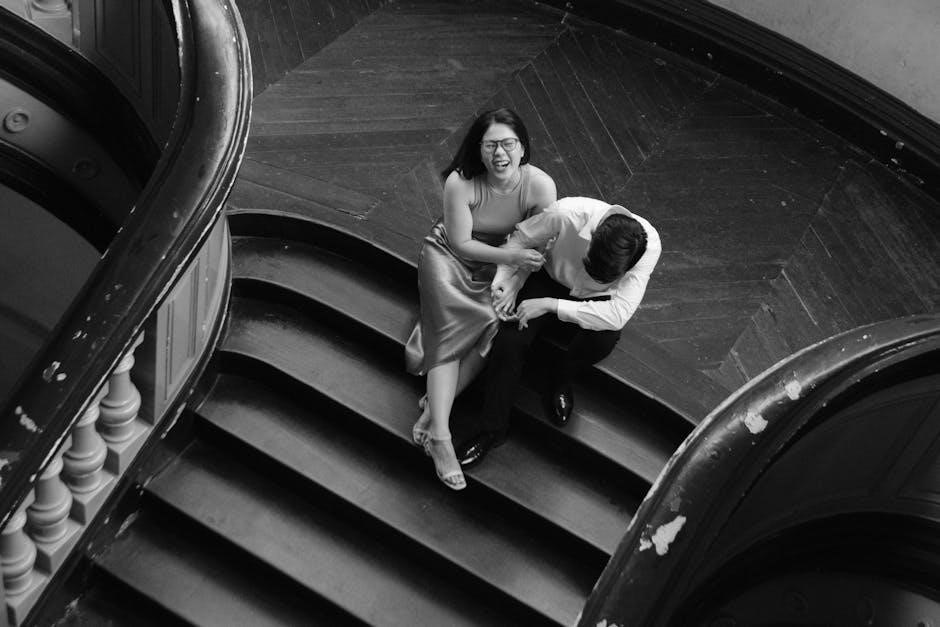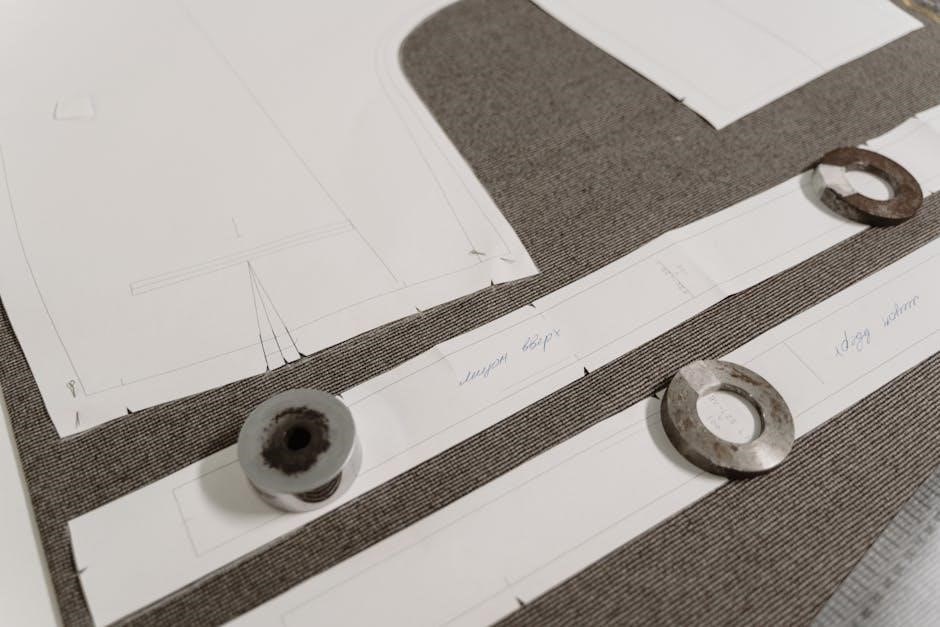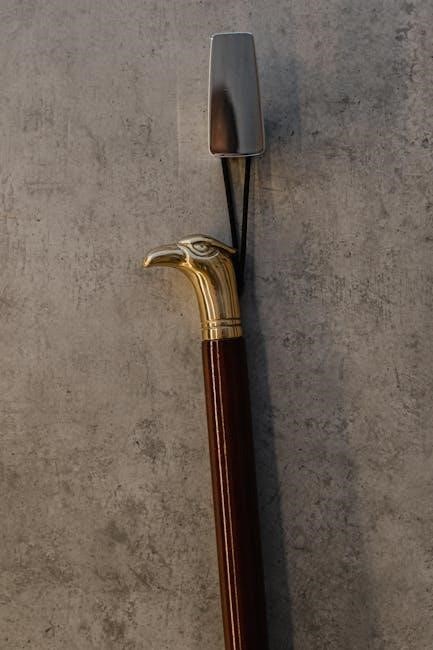
Understanding men’s dress shirt measurements is key to achieving a perfect fit. Proper neck size, sleeve length, and chest measurements ensure comfort, style, and confidence, making them essential for a polished look.
Why Proper Fit Matters
A well-fitted dress shirt enhances professionalism and confidence, creating a polished appearance. Proper measurements ensure comfort, allowing freedom of movement while maintaining a streamlined look. An ill-fitting shirt can be restrictive, affecting both style and functionality. A tailored fit boosts confidence, making it essential for formal events or business meetings. It also ensures the shirt drapes correctly, avoiding a boxy or overly tight silhouette. Accurate sizing prevents discomfort and distractions, ensuring you feel as good as you look. Investing in the right fit is crucial for making a strong impression and enjoying long-lasting wear. Proper fit balances aesthetics and comfort, making it a cornerstone of a well-put-together wardrobe.
Key Measurements for Dress Shirts
The primary measurements for dress shirts include neck size, sleeve length, chest, waist, and shoulders. Neck size is crucial for collar comfort, while sleeve length ensures arms move freely. Chest measurement determines how the shirt fits across the torso, and waist measurement ensures a tailored look. Shoulder measurements ensure the shirt sits properly without drooping or tightness. These measurements are essential for a balanced fit, ensuring comfort and style. Accurate sizing in these areas guarantees the shirt hangs well and complements the body shape, making these measurements fundamental to selecting the right dress shirt.

Understanding Standard Sizing
Standard sizing for men’s dress shirts is based on neck size and sleeve length, with neck sizes ranging from 13 to 19 inches and sleeve lengths categorized as Short, Regular, or Long.
Neck Size and Sleeve Length
Neck size is the primary measurement for dress shirts, increasing in half-inch increments from 13 to 19 inches. Sleeve length is categorized as Short (30-32″), Regular (32-34″), or Long (34-36″). Proper fit ensures comfort and style, avoiding restrictive collars or overly long sleeves. Measure around the neck at the Adam’s apple with one finger inside the shirt for collar size. Sleeve length is measured from the center back of the neck, over the shoulder, to the desired cuff length. Accurate measurements ensure a tailored fit, crucial for professional or formal appearances. Always refer to size charts for precise fitting, as sizes can vary between brands.
Chest, Waist, and Shoulder Measurements
Chest, waist, and shoulder measurements are crucial for ensuring a well-fitted dress shirt. The chest measurement is taken across the broadest part of the chest, typically ranging from 38-50 inches. Waist measurements, often 2-4 inches smaller than the chest, ensure the shirt isn’t too loose. Shoulder measurements, spanning from one shoulder tip to the other, ensure the shirt sits comfortably without sagging. Proper alignment of these measurements ensures a balanced fit, avoiding a boxy or restrictive feel. Always consult a size chart to match your measurements accurately, as variations exist between brands. Accurate chest, waist, and shoulder measurements guarantee a shirt that drapes naturally, enhancing both comfort and appearance.

How to Measure Yourself
Use a flexible tape measure to take accurate chest, waist, and shoulder measurements. Ensure the tape is level and snug but not tight for the best fit.
Measuring the Collar
To measure the collar, wrap a flexible tape measure around the base of your neck, just above your Adam’s apple; Keep the tape level and parallel to the floor. The tape should be snug but not tight, allowing room for one finger. This measurement determines the collar size, which is crucial for a comfortable fit. Proper collar measurement ensures the shirt sits correctly around the neck without being too tight or too loose. Stand up straight while measuring to get an accurate reading. Note that collar sizes typically range from 13 to 19 inches, increasing in half-inch increments. Accurate collar measurement is essential for a professional and polished appearance.
Measuring Sleeve Length
Measuring sleeve length requires precision to ensure the perfect fit. Start by standing upright with your arms relaxed at your sides. Place the tape measure at the center back of your neck, just below the collar. Extend the tape down over your shoulder, following the natural curve of your arm, and stop at your wrist. This length determines the sleeve length of your shirt. Sleeve lengths typically range from 30 to 37 inches, with standard options like 32/33 inches or 34/35 inches. Proper sleeve length ensures the shirt looks tailored and professional, avoiding sleeves that are too short or overly long. Accurate measurement is vital for a polished and comfortable fit.
Measuring Chest and Waist
Accurate chest and waist measurements are crucial for a well-fitting dress shirt. To measure your chest, wrap the tape measure around the fullest part of your torso, keeping it parallel to the floor. Ensure the tape is snug but not tight, typically resulting in measurements between 38 to 52 inches. For the waist, measure around the narrowest point, usually just above the hipbone. This measurement ranges from about 30 to 45 inches. Proper chest and waist measurements ensure the shirt isn’t too tight or too loose, providing a comfortable and tailored appearance. These measurements are essential for selecting the right size from a standard size chart, ensuring both style and comfort.

Size Charts and Fit Guide
A size chart and fit guide help determine the ideal shirt size based on key measurements like neck, chest, and sleeve length, ensuring a perfect fit.
Standard Size Chart for Dress Shirts
A standard size chart for dress shirts typically includes measurements for neck, chest, waist, and sleeve length. Neck sizes range from 13 to 19 inches, increasing by half-inch increments. Sleeve lengths are categorized as short, regular, or tall, with measurements like 32/33 or 34/35 inches. Chest measurements correspond to the neck size, ensuring a balanced fit. Waist sizes are often proportionate to chest measurements, providing a tailored look. Understanding these measurements helps in selecting the right size, ensuring comfort and style.
How to Read the Size Chart
Reading a dress shirt size chart involves matching your measurements to the corresponding sizes. Start by identifying your neck size, as it is the primary measurement. Sleeve length follows, with options for regular, tall, or short fits. Chest and waist measurements are secondary, ensuring the shirt is not too tight or loose. Compare your measurements to the chart, ensuring alignment with the nearest size. Pay attention to the fit type (slim, classic, or relaxed) to match your body type. Accurate measurements are crucial for the best fit. Use the chart to guide your selection, ensuring comfort and style. This process helps you find the ideal shirt that meets your needs.

Types of Fits
Mens dress shirts come in slim, classic, and relaxed fits. Slim fit is tailored for a modern look, while classic offers a traditional, comfortable style. Relaxed fit provides a looser, casual feel.
Slim Fit vs. Classic Fit
A slim fit dress shirt is tailored closer to the body, offering a modern, streamlined appearance. It features a narrower chest, shorter sleeves, and a shorter overall length, ideal for those with a lean build or seeking a contemporary style. In contrast, a classic fit provides a traditional, comfortable cut with more room across the chest, shoulders, and waist. It suits a broader range of body types and is perfect for formal or business-casual settings. While slim fit emphasizes fashion and a youthful vibe, classic fit prioritizes versatility and timeless appeal. Both styles ensure a polished look, but the choice depends on personal preference, body shape, and the desired aesthetic.
Relaxed Fit and Other Styles
A relaxed fit dress shirt offers a roomier, more comfortable cut compared to slim or classic fits. It is designed for individuals who prefer a looser silhouette or have a broader build. This style allows for ease of movement and is ideal for casual or business-casual settings. Beyond slim and classic fits, other styles such as contemporary or athletic fits cater to specific needs. Contemporary fit strikes a balance between slim and classic, offering a modern yet versatile option. Athletic fit is tailored for those with broader shoulders and chests, ensuring a flattering and comfortable fit. These diverse styles provide versatility, allowing men to choose a shirt that aligns with their body type, lifestyle, and personal fashion preferences, ensuring both comfort and a polished appearance.
Common Mistakes to Avoid
Common mistakes include choosing the wrong collar size, ignoring sleeve length, and not considering fabric stretch. These errors can lead to an ill-fitting shirt.
- Not measuring accurately.
- Ignoring the importance of neck and sleeve measurements;
- Overlooking fabric type and stretch.
Choosing the Wrong Collar Size
Choosing the wrong collar size is a common mistake that can ruin the fit of a dress shirt. A collar that is too tight can be uncomfortable and restrictive, while one that is too loose may look sloppy and unprofessional. Proper collar measurement is essential, as it directly impacts both comfort and appearance. To avoid this, measure the neck circumference accurately, ensuring the tape measure is level and not too tight or too loose. Compare the measurement to the size chart, selecting the closest match. Remember, the collar should allow for a finger’s space between the neck and the shirt for optimal comfort; Ignoring this step can lead to a shirt that feels constricting or looks ill-fitting.
- Measure the base of the neck for accurate sizing.
- Ensure the tape measure is not too tight or too loose.
- Refer to the size chart for the correct collar size range.
Pro Tip: Always leave a little room for comfort, as a collar that is too tight can be uncomfortable throughout the day.
Ignoring Sleeve Length
Ignoring sleeve length is a common oversight that can significantly affect the fit and appearance of a dress shirt. Sleeve length should be measured from the center back of the neck to the wrist, ensuring the shirt cuff rests just past the wristbone. A sleeve that is too short can make the shirt look ill-fitting, while one that is too long can appear bulky and unprofessional. Proper sleeve length ensures a balanced look and optimal comfort. Always refer to the size chart for standard sleeve measurements, as they vary slightly between brands. For example, a 32/33 sleeve length is common for shorter builds, while 34/35 is more suitable for average heights. Remember, sleeve length is just as important as neck size for achieving a polished, tailored look.
- Measure from the center back of the neck to the wrist for accuracy.
- Ensure the cuff reaches just past the wristbone.
- Compare measurements to the size chart for the best fit.
Pro Tip: Sleeve length should complement your height and build for a seamless, professional appearance.

Tips for the Perfect Fit
Accurate measurements and understanding fabric stretch ensure a tailored fit. Consider your body type for slim or classic styles, enhancing both comfort and style effortlessly. Use size charts for guidance, ensuring a polished look. Proper fit boosts confidence, so take time to measure correctly for the best results. Tailored shirts ensure a professional appearance, so prioritize fit for a sharp look. Measure the collar, sleeves, chest, and waist to select the ideal size. Use online guides or tape measures for precision. Ensure the shirt isn’t too tight or loose, allowing freedom of movement. Pair measurements with style preferences for a perfect balance. Double-check size charts for consistency across brands. Remember, fit is key to a stylish, comfortable dress shirt. Ensure accuracy for a polished look, as proper fit enhances your overall appearance. Tailored fit shirts offer both style and comfort, making them a wardrobe essential. Always verify measurements before purchasing. Choose the right fabric for your needs, whether stretch or breathable materials. Pay attention to sleeve length and collar size for a balanced look. Use a flexible tape measure for precise body measurements. Consider seeking a tailor’s advice for custom fits. Ensure the shirt fits well when standing and sitting. Use size charts as a guide but trust your measurements for the best fit. Opt for brands that offer detailed size charts for accuracy. Always check the return policy in case adjustments are needed. Ensure the collar fits comfortably without being too tight. Sleeve length should allow cuffs to rest just past the wrist. Pair your shirt with the right pants and accessories for a cohesive look. Proper fit ensures confidence and style, so invest time in measuring accurately. Choose shirts with breathable fabrics for comfort. Ensure the shirt’s length is proportionate to your torso for a balanced look. Consider the occasion when selecting fit and fabric. Use a full-length mirror to assess fit after purchasing. Ensure the shirt moves freely without restrictiveness. Tailored fit shirts are versatile for both formal and casual events. Always measure regularly to update your size preferences. Ensure the fit complements your build for a flattering appearance. Use the internet guides for precise measurements and style tips. Ensure the shirt’s design aligns with your personal style for confidence. Proper fit is essential for both aesthetics and comfort. Trust your measurements for the best fit, ensuring a polished look.
Accurate measurements are crucial for a perfectly fitting dress shirt. Start by using a flexible tape measure and standing naturally. For the collar, measure around the base of your neck, keeping the tape snug but not tight. For sleeve length, measure from the center back of your neck, over your shoulder, and down to your wrist. Chest measurements should be taken around the widest part of your torso, ensuring the tape is level and not too tight. Waist measurements are taken at the narrowest point, typically just above the hipbone. Double-check each measurement to avoid errors. Use a full-length mirror to ensure the tape is straight and level. Consider having someone assist you for precise results. Record your measurements and compare them to the size chart for the best fit. Consistency is key, so measure regularly as your size may change over time. Always refer to the specific brand’s size chart, as sizes can vary slightly. By following these steps, you can ensure your measurements are accurate and reliable, leading to a dress shirt that fits perfectly and enhances your appearance. Proper measurements not only improve comfort but also the overall style of the shirt, making it essential to take the time to get them right. Fabric type and stretch play a significant role in how a dress shirt fits and feels. Cotton is the most common material, offering breathability and a classic look, while polyester blends provide durability and wrinkle resistance. Stretch fabrics, such as those with elastane, offer flexibility and comfort, ideal for active lifestyles. Non-stretch fabrics, like pure cotton, maintain their shape but may feel stiffer. Minimal stretch fabrics, such as Oxford cloth, balance comfort and structure. High-stretch fabrics, like those in slim-fit shirts, allow for ease of movement. Understanding the fabric’s properties helps in choosing the right fit, as stretch fabrics can accommodate varying body types more forgivingly. Always consider the fabric when selecting your size to ensure optimal comfort and appearance. Proper fit is essential for style and comfort. Understanding measurements and fabric types helps choose the right shirt. Use this guide to find your perfect fit. Accurate measurements are crucial for a tailored fit. Ensuring the right neck size, sleeve length, and chest circumference guarantees both style and comfort. Remember, proper fit enhances your appearance and confidence. Always refer to size charts and consider fabric stretch for the best results. Taking the time to measure correctly ensures a polished, professional look. Don’t overlook details like collar fit and sleeve length to avoid common mistakes. Investing in a well-fitted dress shirt elevates your wardrobe and makes a lasting impression. By following these guidelines, you can effortlessly find your ideal shirt and maintain a sharp, put-together style. Now that you understand the importance of measurements, it’s time to take action. Start by measuring yourself or visiting a tailor for precise dimensions. Use these measurements to refer to a size chart, ensuring accuracy. Consider the fit style—slim, classic, or relaxed—that suits your body type and preference. When shopping, double-check the fabric and stretch, as these can affect fit. Finally, order your shirt and try it on immediately to confirm the fit. If needed, adjust your size or seek alterations. By following these steps, you’ll effortlessly find a dress shirt that combines comfort, style, and confidence, completing your professional wardrobe with ease.How to Ensure Accuracy in Measurements
Understanding Fabric and Stretch
Final Thoughts on Dress Shirt Measurements
Next Steps to Finding Your Ideal Shirt